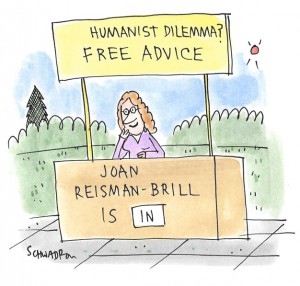The Humanist Dilemma: Should Congress Lift 181-Year Ban on Headgear?

Experiencing an ethical dilemma? Need advice from a humanist perspective?
Send your questions to The Humanist Dilemma at dilemma@thehumanist.com (subject line: Humanist Dilemma).
All inquiries are kept confidential.
Hats Off, Hats On, Who Cares? I just heard that there’s a movement afoot (or ahead) to dispense with the rule banning hats on the floor of the US House of Representatives. I believe it’s come up because newly elected member Ilhan Omar (D-MN), who’s Muslim, wears a headscarf. My immediate reaction was a negative one associated with special treatment for religious people—on the other hand, I couldn’t imagine requiring her to abandon her head covering if she wants to do her job.
After a bit more thought, I really don’t see a problem with allowing headgear in the House. What difference does it make if someone wears a scarf, a skullcap, or a colander? And if people want to show up wearing cowboy hats or MAGA caps or Mickey Mouse ears, shouldn’t that be their prerogative—and wouldn’t it give us some useful information about them?
—No Big Deal
Dear Deal,
I had a similar reaction. Although I oppose rules that permit special privileges for religious reasons (such as denying contraception or refusing to provide services to LGBTQ costumers), as long as the House hat rule permits everyone to wear something on their heads—or not—for any reason, I see no harm in it.
But I’m concerned that instead of allowing all members to wear headgear (or not) at their own discretion, the proposal may permit headwear only as an exception to the no-hats rule, limited to exemptions for religious reasons or for people with illnesses, such as those that cause hair loss. This could open a huge can of worms with arguments over who gets to wear what why. Better to just get rid of any rules regarding hats and assume members of the House could just exercise common sense and courtesy. (Now I’m rereading that sentence and wondering if I should delete it!)
I’m no expert in the history of the hats-off rule, but I know until recently Congress was made up of all men (primarily Christian white men at that). At the time of the American Revolution, I believe men wore wigs that might as well have been hats. I’m also aware that men keeping their hats on indoors has traditionally been viewed as a sign of disrespect, although women have always gotten away with hats as a fashion accessory, even indoors. Certainly, hats that impede other people’s view of the proceedings need to be removed out of consideration, but otherwise, who’s harmed?
My very superficial research suggests that the hats-off rule was an American reaction to British Parliament keeping their hats on. And the ban wasn’t exactly a slam dunk, finally passing in 1837 after the proposal failed multiple times.
Many customs that were once considered de rigueur are no longer relevant now. I believe any ruling about hats in the House is past its expiration date and needs to be removed from the books. I’m with John. M Patton, who represented Virginia in the House in the 1830s and who called the ban against “the really harmless but apparently indecorous practice of wearing our hats” a symptom of meddlesomeness, and sought to defend “the outward and visible sign of the inward and spiritual freedom of this body from all executive control or interference.” Hats off to Mr. Patton.
